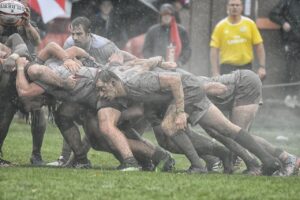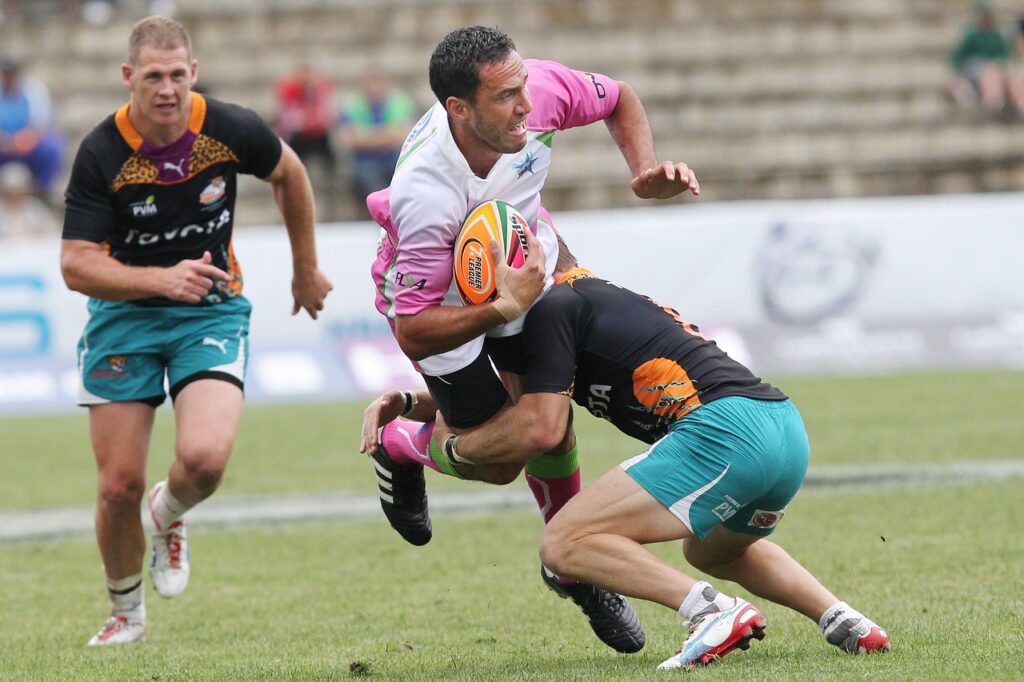RUGBY PHYSICAL TRAINING: THE COMPLETE GUIDE WITH KETTLEBELL
The kettlebell for rugby physical preparation?
Rugby physical preparation is a key element for any player wishing to perform at his or her best. Rugby is a demanding sport, requiring a combination of strength, endurance, speed and agility. For this reason, rugby players devote a great deal of time to physical preparation.
In this article, we’ll focus on the importance of physical preparation in rugby, and more specifically onkettlebell training to improve performance on the field. Discover how rugby physical preparation can make all the difference to your game!
Rugby physical preparation
Components of physical preparation for rugby
General physical preparation is essential for rugby players seeking to improve their performance on the field. It consists of five key principles:
Endurance :
Endurance is crucial for a rugby player, who must be able to run long distances for an extended period of time. Endurance exercises include running, cycling, rowing, circuit work, etc.
Force :
Strength is also important for rugby players, who need to be able to withstand physical shocks on the field. Muscle-strengthening exercises include weight training, body-weight exercises, squats, lunges, bench presses and more.
Power :
Power is the ability to generate maximum force in minimum time. It is important for rugby players who need to be able to perform explosive movements such as jumping or charging. Power exercises include jumps, plyometric exercises, explosive weight loads, etc.
Speed :
Speed is a key element for rugby players, who need to be fast and agile on the field. Speed exercises include sprints, interval runs, etc.
Agility :
Agility is the ability to change direction quickly while maintaining high speed. It is important for rugby players who need to be able to move quickly around the field while avoiding defenders. Agility exercises include zigzagging, quick changes of direction, lateral jumps and so on.
By working on these five principles, rugby players can improve both their general physical preparation and their performance on the field.
Examples of exercises for each component of rugby physical preparation
Endurance :
To develop endurance, rugby players can practice running, swimming, cycling, stair climbing, circuit training or repeated sprints. Circuit exercises are particularly effective for improving endurance, as they involve a series of different exercises that challenge the whole body.
Force :
To develop strength, rugby players can practice muscle-strengthening exercises such as squats, bench presses, deadlifts, pull-ups, push-ups or dips. Weight machines are also useful for targeting specific muscles.
Power :
To develop power, rugby players can practice jumps, medicine ball throws or explosive weight-bearing exercises. Plyometric exercises, which involve jumping, are particularly useful for improving power.
Speed :
To develop speed, rugby players can practice sprints, changes of direction, quick-start drills or interval runs. Speed exercises must be practised regularly to improve speed significantly.
Agility :
To develop agility, rugby players can practice coordination exercises, lateral jumps, change-of-direction drills or fast zigzag movements. Agility exercises can help players improve their balance, coordination and responsiveness on the pitch.

Using the kettlebell for physical preparation in rugby
Advantages of the kettlebell in rugby training
The kettlebell, also known as the “girya”, is a piece of strength training equipment that was developed in Russia in the 18th century. Originally, kettlebells were used to weigh grain and goods in Russian markets. Later, the Russian armed forces began using kettlebells as training equipment to develop strength, endurance and power.
The kettlebell offers many advantages for rugby players. Firstly, it allows you to work several muscle groups at the same time, making it an effective piece of training equipment for improving strength and endurance. In addition, the kettlebell can be used to develop explosive power, thanks to exercises such as swings, cleans and snatches. Finally, the kettlebell is a versatile and inexpensive piece of training equipment, making it a practical choice for rugby players training off the field.
By integrating the kettlebell into their training program, rugby players can improve their strength, endurance and power, which can help them perform optimally on the field.
Strengthening back and leg muscles :
Rugby is a sport that demands a lot of back and leg muscles. Kettlebell exercises such as the swing and goblet squat are particularly effective in strengthening these muscles. By strengthening back and leg muscles, rugby players can improve their power and endurance on the field.
Improved endurance :
Endurance is essential in rugby, as matches can be long and players need to be able to maintain their energy levels throughout. Kettlebell exercises such as the swing and snatch are excellent for improving endurance. These exercises focus on working the whole body, which can help players maintain their energy levels for long periods.
Developing explosive strength :
Explosive strength is essential in rugby, as players need to be able to generate power quickly for actions such as tackling and sprinting. Kettlebell exercises such as the snatch and the clean are ideal for developing explosive strength. These movements focus on transferring strength from the lower to the upper body, which can help rugby players develop the explosive strength needed to succeed on the field.
Improved coordination :
Coordination is a key element in rugby, as players need to be able to change direction and position on the pitch quickly. Kettlebell exercises such as the Turkish get-up can help improve coordination. These exercises require coordination between hand and foot movements, which can help players improve their overall coordination on the pitch.
Kettlebell exercises for rugby physical preparation
Swing :
The swing is one of the most popular kettlebell exercises. It builds strength, endurance and explosive power in the legs, back and abdominals. The swing is a dynamic movement that consists of swinging the kettlebell between the legs, then propelling it forward at chest level using the hips and legs, before letting it fall back down between the legs.
Snatch:
The snatch is another kettlebell exercise for developing explosive power. It consists of lifting the kettlebell off the ground at arm’s length in a single, fluid movement, before lowering it back down again, controlling the movement. The snatch is a demanding exercise that involves many muscle groups, including shoulders, arms, legs and abdominals.
Clean and press :
The clean and press is an exercise that builds strength and power in the shoulders, back and legs. It involves lifting the kettlebell from the ground to shoulder level, before pushing it upwards with the arm stretched above the head. This exercise can be performed with a single kettlebell or two kettlebells simultaneously for an extra challenge.
Turkish get-up:
The Turkish get-up is a complete exercise that builds strength, stability and mobility throughout the body. It consists of rising from the ground with the kettlebell at arm’s length, using a series of controlled movements involving the legs, abdominals, shoulders and arms.
Goblet squat:
The goblet squat is an exercise that builds strength and stability in the legs, glutes, abdominals and upper back. It involves holding the kettlebell in front of the chest with both hands, then bending the legs until the thighs are parallel to the ground, or in full flexion if mobility permits, keeping the back straight.
By incorporating these kettlebell exercises into their training program, rugby players can improve their strength, endurance and power, while working on their stability and mobility. Kettlebell exercises are an effective alternative to traditional bodybuilding movements, and can help rugby players prepare physically for the season.

Rugby physical preparation program with kettlebell
Here’s an example of a kettlebell training program for rugby. The program consists of two typical weeks, with two sessions per week. You can repeat this cycle 3 or 4 times for a total of 6 to 8 weeks of training.
Week 1 – Session 1 :
Warm-up: 10 minutes of cardio (running, cycling, rowing, etc.)
Swing Kettlebell: 3 sets of 15 repetitions
Goblet Squat: 3 sets of 12 repetitions
Kettlebell lunges: 3 sets of 10 repetitions for each leg
Renegade Row: 3 sets of 10 repetitions for each arm
Facelift: Front plank 3 sets of 30 seconds each
Week 1 – Session 2 :
Warm-up: 10 minutes of cardio (running, cycling, rowing, etc.)
Clean and Press Kettlebell: 3 sets of 8 repetitions for each arm
Deadlift Kettlebell: 3 sets of 10 repetitions
Turkish Get-Up: 3 sets of 5 repetitions for each arm
Push-ups: 3 sets of 12 repetitions
Gainage: Superman 3 sets of 30 seconds
Week 2 – Session 1 :
Warm-up: 10 minutes of cardio (running, cycling, rowing, etc.)
Snatch Kettlebell: 3 sets of 10 repetitions for each arm
Goblet Squat Kettlebell: 3 sets of 8 repetitions
Bulgarian Split Squat Kettlebell: 3 sets of 10 repetitions for each leg
Kettlebell Push Press: 3 sets of 8 repetitions for each arm
Gainage: Side plank 3 sets of 30 seconds each side
Week 2 – Session 2 :
Warm-up: 10 minutes of cardio (running, cycling, rowing, etc.)
Single Arm Swing Kettlebell: 3 sets of 10 repetitions for each arm
Kettlebell Front Squat: 3 sets of 12 repetitions
Kettlebell Reverse Lunge: 3 sets of 10 repetitions for each leg
Kettlebell Floor Press: 3 sets of 12 repetitions for each arm
Gainage: Plank on one arm 3 sets of 30 seconds on each side
For each exercise, choose an appropriate kettlebell weight for your fitness level. It is important to rest sufficiently between each series and each session. You can also include stretching and mobility exercises to improve your flexibility and range of motion. Have a good workout!
Conclusion
Physical preparation is therefore a crucial element in rugby performance. Players need to develop endurance, strength, power, speed and agility to be effective on the pitch. Physical preparation can also help prevent injuries and improve recovery after matches.
If you’re a rugby player, it’s important to take physical preparation seriously. By using the principles we’ve described in this article, along with specific kettlebell exercises, you can improve your performance in the field and prevent injury. Devote time and energy to your physical preparation and you’ll see the results on the field.
Other articles that might interest you:
- GPP for running with kettlebell
- MMA physical preparation with kettlebell
- Military training with kettlebell
- Abs exercises with kettlebell
- WOD with kettlebell in CrossFit
- Bodybuilding with kettlebell
- Kettlebell exercises for women
- Kettlebell HIIT
- Kettlebell sport : all you need to know
- Tennis physical preparation with kettlebell
- Handball physical preparation with kettlebell
- Basketball physical preparation with kettlebell
- Skiing physical preparation with kettlebell
- Football physical preparation with kettlebell
Sources :
- https://conseilsport.decathlon.fr/la-preparation-physique-au-rugby
- https://www.prepa-physique.net/preparation-physique-rugby/

